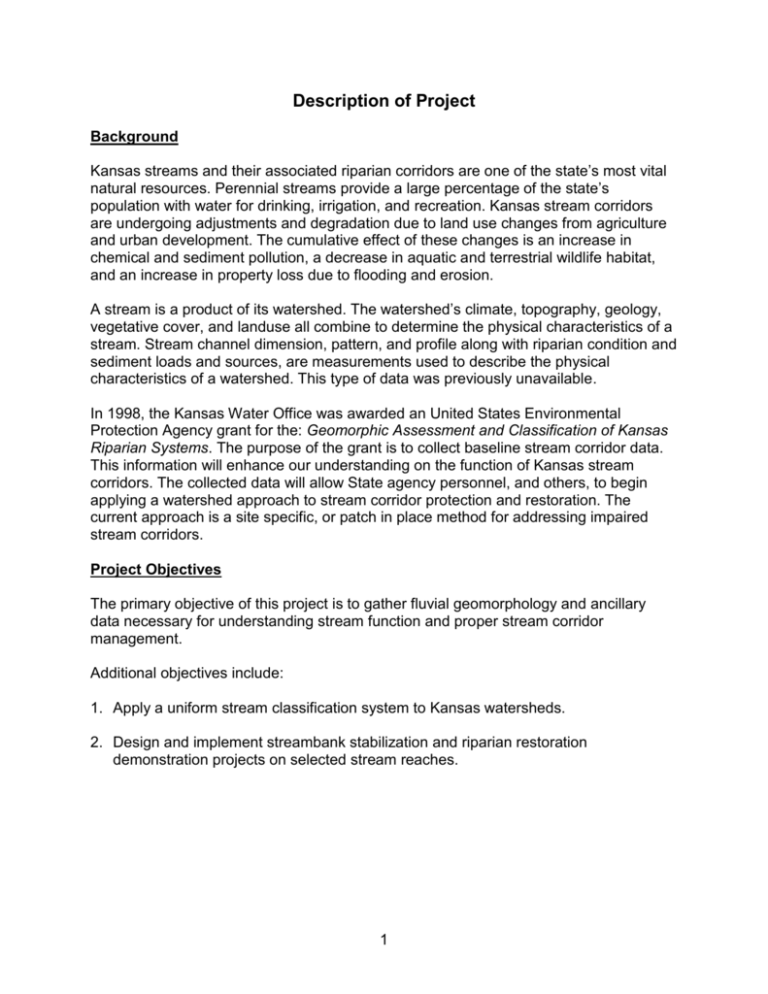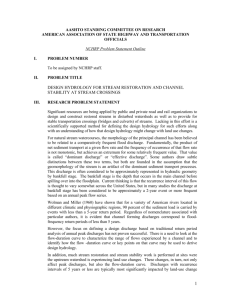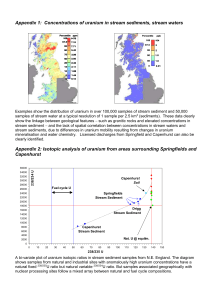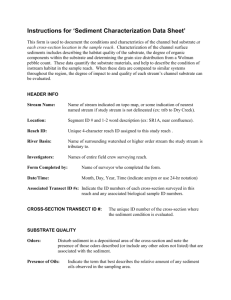Description of Project
advertisement

Description of Project Background Kansas streams and their associated riparian corridors are one of the state’s most vital natural resources. Perennial streams provide a large percentage of the state’s population with water for drinking, irrigation, and recreation. Kansas stream corridors are undergoing adjustments and degradation due to land use changes from agriculture and urban development. The cumulative effect of these changes is an increase in chemical and sediment pollution, a decrease in aquatic and terrestrial wildlife habitat, and an increase in property loss due to flooding and erosion. A stream is a product of its watershed. The watershed’s climate, topography, geology, vegetative cover, and landuse all combine to determine the physical characteristics of a stream. Stream channel dimension, pattern, and profile along with riparian condition and sediment loads and sources, are measurements used to describe the physical characteristics of a watershed. This type of data was previously unavailable. In 1998, the Kansas Water Office was awarded an United States Environmental Protection Agency grant for the: Geomorphic Assessment and Classification of Kansas Riparian Systems. The purpose of the grant is to collect baseline stream corridor data. This information will enhance our understanding on the function of Kansas stream corridors. The collected data will allow State agency personnel, and others, to begin applying a watershed approach to stream corridor protection and restoration. The current approach is a site specific, or patch in place method for addressing impaired stream corridors. Project Objectives The primary objective of this project is to gather fluvial geomorphology and ancillary data necessary for understanding stream function and proper stream corridor management. Additional objectives include: 1. Apply a uniform stream classification system to Kansas watersheds. 2. Design and implement streambank stabilization and riparian restoration demonstration projects on selected stream reaches. 1 Project Approach The predominate factor affecting the physical characteristics of stream corridors is bankfull flow. Bankfull flow is the peak of effective discharge and determines the physical characteristics and dimensions of a stream channel. It is the dominant channelforming flow. This volume of flow varies from stream to stream, but the frequency of occurrence for most streams is similar. In Kansas, bankfull flow has a recurrence interval between 1.1 and 1.6 years depending on the stream’s drainage area and location in the state. The recurrence range reflects the flood frequency over time; meaning that the bankfull flow may not occur at this frequency from year to year, but rather it is likely to occur. Large flow events are too infrequent to govern channel characteristics, though high flow events are effective at channel change when they do occur (Dunne and Leopold, 1978). Low flow conditions are common and frequent and ineffective at shaping the channel (Dunne and Leopold, 1978). There are several bankfull flow indicators in Kansas. These include: the presence of an active floodplain at the incipient point of flooding, an elevation associated with the top of the highest depositional features, a break in bank slope, a change in particle size distribution, presence of small benches, and exposed roots below an intact soil layer. These indicators are not consistent from site to site nor are they always readily visible. To document the correct elevation of the bankfull flow, data is collected at or near United States Geological Survey (USGS) stream-flow gaging stations. USGS maintains approximately 140 stream-flow gaging stations in Kansas. Streamflow data collected at each site includes: width, area, mean velocity, water elevation, and discharge. The drainage area is also documented for each gage station. This data is collected on a frequent basis for a water resource information database. Over time, this information is recorded for a wide variety of flow conditions, and is documented in discharge notes (9207 forms). USGS also develops rating tables for each gage. These tables list the discharge at a particular elevation. Further data analysis of the USGS measurements provide information for two aspects of the stream flow: 1) flood recurrence interval, in years, from flood frequency analysis and 2) hydraulic geometry data for channel width, depth, cross sectional area, and flow velocity vs. stream discharge. Regression analysis is performed on the latter to obtain relationships between discharge and the width, depth, cross sectional area, and velocity of a particular flow. In many cases these relationships are very accurate. Collecting data at USGS gage locations is necessary to verify a field determined bankfull stage. At the present time, surveying is complete at 86 gaging stations. Some stations are excluded due to controlled flow conditions immediately upstream of the gaging station (reservoirs). Data Collection Procedures In order to document the physical characteristics of stream corridors, surveys are conducted to determine the dimension, pattern, profile, riparian condition, and sediment yield (at a given discharge) for each suitable USGS gage station. 2 Dimension Each site survey has at least one cross section. Several surveys have cross sections for riffles and pools; and others for reference and degraded stream reaches. Rebar pins are placed at each end of the cross section to allow additional surveys to measure the same cross section and document any changes. Each cross section normally starts at the top of left bank and ends at top of right bank. The cross section used to determine dimension data is located on a riffle or cross over section of the stream reach. These locations in a stream tend to have the highest stability. The following information is gathered from each cross section survey: 1. Bankfull Width 2. Bankfull Mean Depth 3. Bankfull Cross Sectional Area 4. Width / Depth Ratio 5. Maximum Depth 6. Width of Flood Prone Area 7. Entrenchment Ratio 8. Wetted Perimeter 9. Mean Velocity @ Bankfull Stage 10. Bankfull Discharge Estimate 11. Ratio: Lowest Bank Height / Bankfull Maximum Depth Pattern Channel pattern data is collected for each site to document the configuration of the channel as it meanders through the valley. Most of this data is gathered in the office instead of the field. Aerial photographs provide a reliable source for scale measurements of the channel meander geometry. The following data is collected for each site: 1. 2. 3. 4. 5. Channel Sinuosity Meander Length Belt Width Radius of Curvature (sometimes measured in field) Meander Width Ratio Profile A longitudinal profile is surveyed for each gage site. Survey shots are taken along the thalweg for at minimum distance of one meander length. At each survey point along the thalweg, the elevation of the thalweg, edge of water, and bankfull elevation is documented. Longitudinal profiles vary from site to site depending on the dominant sediment size. Streams dominated by sand 3 (e.g. Republican, Kansas, Arkansas, and Ninnescah Rivers) typically do not have a prevalent riffle-pool sequence. Streambed sand is constantly moving and shifting which creates an undulating streambed with few dominate streambed sequences. In such cases, water surface slopes are only determined from the profile. Otherwise, the following data is determined from each longitudinal profile: 1. 2. 3. 4. Average Water Surface Slope Riffle Slope and Pool Slope (if applicable) Riffle / Pool Sequences (if applicable) Bankfull Stage Slope Riparian Condition There are two visual assessments completed at each site. They are Proper Functioning Condition (PFC) and Stream Visual Assessment Protocol (SVAP). The US Department of Interior, Bureau of Land Management (BLM) and the US Department of Agriculture, Forest Service (FS) and Natural Resources Conservation Service (NRCS) developed the guide for PFC. SVAP was developed by the US Department of Agriculture, Natural Resources Conservation Service. The PFC guide was developed to qualitatively assess how well the physical processes are functioning in riparian and wetland areas. This assessment uses a checklist to synthesize information that is foundational to determining the overall health of a riparian or wetland system (Prichard et al. 1998). The checklist is divided into three categories, hydrology, vegetation, and erosion/deposition. Each section has a series of yes/no questions and then a summary determination that rates the function of the riparian-wetland area. SVAP is used to provide a basic level of stream health evaluation (USDANRCS, 1998). It differs from the PFC assessment in that the user determines a rating based on a variety of physical conditions. The assessment provides a series of scores ranging from poor to excellent to describe each section. There are some conditions that may not be rated, so the final score is the overall score divided by the number of physical conditions scored. Both of these assessments are used because they are reliable, reproducible, and are consistent without being extremely time consuming. These assessments also provide an overall picture of the health of riparian or wetland areas state wide and when performed over time, will show trends or changes in condition. Sediment Sampling The final measurement taken is sediment sampling. One of a stream’s functions is to move sediment through the watershed. This is a very important 4 function of the stream corridor system. Sediment is listed as one of the pollutants of concern for Total Daily Maximum Loads (TMDLs) determination. Little rigorous sediment data has previously been collected for Kansas steams. Collecting sediment is a procedure that requires a great deal of time and a variety of flow conditions per site. Each stream has the ability to carry a specific sediment load for a given discharge. Thus, it is important to develop a sediment rating curve per site. This rating curve relates sediment discharge as a function of stream discharge. One goal of the current project is to establish a sediment collection network. Additional time is needed beyond the current grant’s term to accurately collect data and understand the role of sediment in Kansas’ river basins. One goal of this project was to collect sediment samples at each survey site. Because of the current grant’s term, not every survey site was chosen for sediment collection. When sediment is collected, the technique used is the equal discharge increment method for suspended sediment, and the unequalwidth-increment method for bedload discharge (Edwards and Glysson, 1999). These methods require fewer samples at each cross section and the samples are located along the cross section in order to delineate equal portions of the cross section discharge. On some sites, with high erosion potential, rebar pins are driven flush into an eroding streambank to measure the rate and volume of erosion. Following a high flow event, any exposed pins are measured and then driven back into the bank. This data provides a two-dimensional quantity of materials lost. Multiply the height and depth of soil lost by the length of the eroded bank provides a volume of eroded soil. This process provides information on the location of sediment sources and can provide information for stabilization site prioritization. Most monitoring sites are placed in areas where local interest in erosion monitoring exists. This assures someone can measure the amount of eroded material after each high flow event. Project results The results of the dimension, pattern, and profile data will develop several geomorphic conclusions. One will be a stream classification system for the state. David L. Rosgen developed the stream classification used in this project. The classification system uses a morphological documentation of stream characteristics and groups then into relatively homogeneous stream types (Rosgen, 1994). Rosgen (1996) developed the stream classification with these specific objectives: 1. Predict a river’s behavior from its appearance. 2. Develop hydraulic and sediment relationships for a stream type and its state. 3. Provide a mechanism to extrapolate site-specific data to stream reaches having similar characteristics. 5 4. Provide a consistent frame of reference for communicating stream morphology and condition among a variety of interested parties This project will provide Kansans with a stream classification system that can assist in organizing and grouping river data into categories of similar channel morphology. The database will help communicate information on this important and complex natural resource. Another project outcome is the development of regional runoff curves. Regional curves are data supported graphs that are used to determine the bankfull discharge for ungaged stream locations. The first step in regional curve development is delineating hydro-physiographic regions within the state. Hydro-physiographic regions are drainage basins that have similar climate and geology. Streams in particular regions have strong linear relations between drainage area and bankfull channel dimensions. This information can be used to help determine the bankfull flow and channel dimensions on ungaged streams, when a drainage area is known. The goal is to continue refining them as more data is collected. New data will help increase the linear relationships and divide the state into proper hydro-physiographic regions. Sediment samples analysis, suspended and bedload, will quantify the concentration of sediment for a given discharge. This portion of the current project will help determine the volume of sediment moving through a watershed. Eventually, with continuing data collection, sediment rating curves can be developed for all Kansas streams. Conclusion The current project’s main goal is to increase the state’s knowledge on stream corridor systems. In return, the knowledge will help us better understand stream processes and develop solutions to repair impaired stream corridors. This knowledge can be brought to bear when a member of the agriculture or urban community is seeking assistance to improve stream corridors. Project information dissemination is an important part of the research effort. We hope that sharing this information will allow others to improve stream conditions and provide them with information for proper stream corridor management. References Edwards, T.K. and Glysson, G.D. 1999. Field Methods for Measurement of Fluvial Sediment. U.S. Geological Survey Techniques of Water-Resources Investigations, Book 3, Applications of Hydraulics, Chapter C2. 89 pp. Prichard, D., Anderson, J., Correll, C., Foggs, J., Gebhardt, K., Krapf, R., Leonard, S., Mitchell, B., and Staats, J. 1998. Riparian Area Management: a user guide to assessing proper functioning condition and the supporting science for lotic areas. TR 1737-15. Bureau of Land Management, BLM/RS/ST-98/001+1737, National Applied Resource Sciences Center, CO. 126 pp. 6 Rosgen, D.L. 1994. A Classification of Natural Rivers. Cantena, Vol. 22. pp. 169-199. Rosgen, D.L. 1996. Applied River Morphology. Wildland Hydrology. Pagosa Springs, CO. 352 pp. USDA Natural Resource Conservation Service. 1998. Stream Visual Assessment Protocol. Technical Note 99-1. NRCS National Water and Climate Center, Portland, OR. 34 pp. 7








